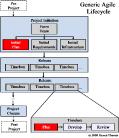In response to my request for questions along the lines of what do I do when … ? Jo asked:
What do I do when the product backlog is not complete and we still want to deliver our product on the agreed date? It is hard for the Product Owner to prepare a complete feature backlog and for developers to estimate the required time in order to get a realistic burndown chart during the sprints. The product backlog is kind of dynamic.
In response I’m going to look at three states for the product backlog and strategies for managing backogs when in each of those states:
- Normally vague/dynamic
- Completely vague
- Massively dynamic
The first of these states is, well, normal. You never know everything about the scope. You just have to manage what you do know.
The other two states suggest something is going wrong in the product management space. And that is very much a product owner issue. The agile project manager / scrum master role is to help the product owner and/or organisation realise their problem.
Continue reading
